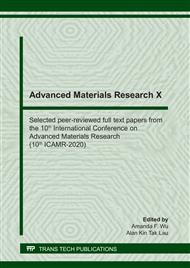[1]
N. Muradov, B. Fidalgo, Gujar, A.C. Garceau, A. T-Raissi, Production and characterization of Lemna minor biochar and its catalytic application for biogas reforming, Biomass and Bioenergy 42 (2012) 123-131.
DOI: 10.1016/j.biombioe.2012.03.003
Google Scholar
[2]
G. Moussavi, R. Khosravi, Preparation and characterization of a biochar from pistachio hull biomass and its catalytic potential for ozonation of water recalcitrant contaminants, Bioresource Technology 119 (2012) 66–71.
DOI: 10.1016/j.biortech.2012.05.101
Google Scholar
[3]
P. Sathishkumar, M. Arulkumar, T. Palvannan, Utilization of agro-industrial waste Jatropha curcas pods as an activated carbon for the adsorption of reactive dye Remazol Brilliant Blue R (RBBR), Journal of Cleaner Production 22 (2012) 67-75.
DOI: 10.1016/j.jclepro.2011.09.017
Google Scholar
[4]
M. Dizbay-Onat, U.K. Vaidya, C.T. Lungu, Preparation of industrial sisal fiber waste derived activated carbon by chemical activation and effects of carbonization parameters on surface characteristics, Industrial Crops and Products 95 (2017) 583–590.
DOI: 10.1016/j.indcrop.2016.11.016
Google Scholar
[5]
H. Saygili, F. Güzel, High surface area mesoporous activated carbon from tomato processing solid waste by zinc chloride activation: process optimization. characterization and dyes adsorption, Journal of Cleaner Production 113 (2016) 995-1004.
DOI: 10.1016/j.jclepro.2015.12.055
Google Scholar
[6]
J.R. Baseri, P.N. Palanisamy, P. Sivakumar, Preparation and characterization of activated carbon from thevetia peruviana for the removal of dyes from textile wastewater, Adv. Appl. Sci. Res. 3 (2012) 377–383.
Google Scholar
[7]
N. Borchard, A. Wolf, V. Laabs, R. Aeckersberg, H.W. Scherer, A. Moeller & W. Amelung, Physical activation of biochar and its meaning for soil fertility and nutrient leaching – a greenhouse experiment, Soil Use and Management 28 (2012) 177–184.
DOI: 10.1111/j.1475-2743.2012.00407.x
Google Scholar
[8]
K.Y. Foo, B.H. Hameed, Preparation, characterization and evaluation of adsorptive properties of orange peel based activated carbon via microwave induced K2CO3 Activation, Bioresource Technology 104 (2012) 679–686.
DOI: 10.1016/j.biortech.2011.10.005
Google Scholar
[9]
H. Deng, G. Li, H. Yanga, J. Tanga, J. Tanga, Preparation of activated carbons from cotton stalk by microwave assisted KOH and K2CO3 activation, Chemical Engineering Journal 163 (2010) 373–381.
DOI: 10.1016/j.cej.2010.08.019
Google Scholar
[10]
S. Darmawan, N.J. Wistara, G. Pari, A. Madsu, and W. Syafii, Characterization of Lignocellulosic Biomass as Raw Material for the Production of Porous Carbon-based Materials, Bioresources 11(2) (2016) 3561–3574.
DOI: 10.15376/biores.11.2.3561-3574
Google Scholar
[11]
P.N. Bhandari, A. Kumar, D.D Bellmer, R.L. Huhnke, Synthesis and evaluation of biochar-derived catalysts for removal of toluene (model tar) from biomass-generated producer gas, Renewable Energy 66 (2014) 346-353.
DOI: 10.1016/j.renene.2013.12.017
Google Scholar
[12]
C. Cheng, H. Liu, P. Dai, X. Shen, J. Zhang, T. Zhao, Z. Zhu, Microwave-assisted preparation and characterization of mesoporous activated carbon from mushroom roots by phytic acid (C6H18O24P6) activation, Journal of the Taiwan Institute of Chemical Engineers 67 (2016) 532–537.
DOI: 10.1016/j.jtice.2016.08.032
Google Scholar
[13]
D. Xin-hui, C. Srinivasakannan, P. Jin-hui, Z. Li-bo, Z. Zheng-yong, Comparison of activated carbon prepared from Jatropha hull by conventional heating and microwave heating, Biomass and Bioenergy 35 (2011) 3920-3926.
DOI: 10.1016/j.biombioe.2011.06.010
Google Scholar
[14]
T. Tay, S. Ucar, S. Karagöz, Preparation and characterization of activated carbon from waste biomass, Journal of Hazardous Materials 165 (2009) 481–485.
DOI: 10.1016/j.jhazmat.2008.10.011
Google Scholar


